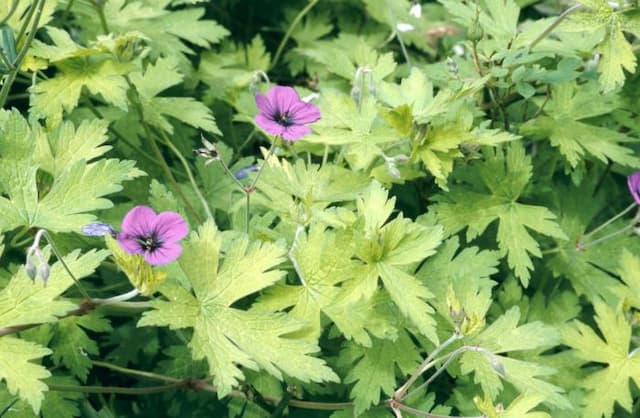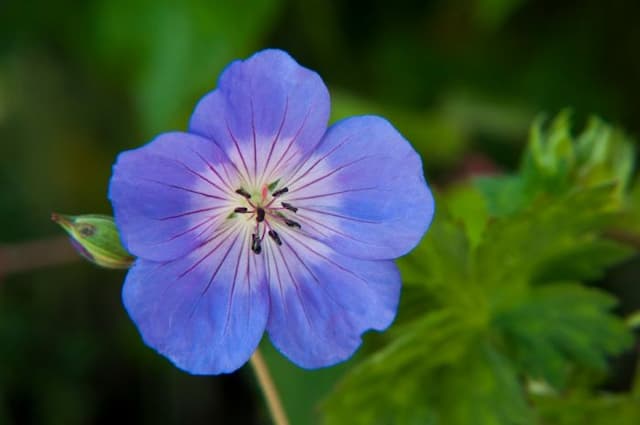Cranesbill Geranium 'Blue Cloud'

ABOUT
The Geranium 'Blue Cloud' is a perennial plant that is cherished for its decorative and striking flowers, which present a captivating display when in bloom. The blossoms of this cultivar exhibit a beautiful shade of blue, often with hints of purple, that stand out brightly against the plant's verdant foliage. Each flower typically consists of five rounded petals that create a saucer-like shape, attracting both visual admiration and pollinating insects. The leaves of the Geranium 'Blue Cloud' are equally attractive, contributing to the plant's ornamental value. They are usually rounded, displaying deep lobes that can sometimes give them a more dissected appearance. Their texture can be described as somewhat velvety to the touch, and their color tends to be bright green, which forms a lush backdrop for the blue flowers. Throughout the growing season, the Geranium 'Blue Cloud' forms a mounded clump of these leaves, with flowering stems rising above the foliage. These stems are slim but sturdy, supporting groups of flowers that float like a cloud above the plant's base. The harmonious contrast between the blue-violet flowers and green leaves creates a serene and picturesque scene in any garden setting where it is planted.
About this plant
 Names
NamesFamily
Geraniaceae
Synonyms
Blue Cloud Geranium, Cranesbill
Common names
Geranium pratense 'Blue Cloud'.
 Toxicity
ToxicityTo humans
Geraniums, including the 'Blue Cloud' variety, are not considered highly toxic to humans. However, some individuals may experience mild irritation or an allergic reaction upon contact with the plant or its sap. In rare cases, ingestion of the plant may cause minor symptoms such as nausea, vomiting, or diarrhea. It is generally advisable to avoid eating any part of the geranium plant.
To pets
Geraniums, such as the 'Blue Cloud' variety, can be toxic to pets, particularly to dogs and cats. If a pet ingests parts of a geranium, symptoms of poisoning may include vomiting, depression, anorexia, and dermatitis. In severe cases, ingestion could lead to more serious conditions, but these instances are relatively rare. It is important to keep geraniums out of reach of household pets to prevent any potential negative effects.
 Characteristics
CharacteristicsLife cycle
Perennials
Foliage type
Deciduous
Color of leaves
Green
Flower color
Blue
Height
1-2 feet (30-60 cm)
Spread
1-2 feet (30-60 cm)
Plant type
Herb
Hardiness zones
5
Native area
Mediterranean
Benefits
 General Benefits
General Benefits- Attracts pollinators: Geranium 'Blue Cloud' is known to attract bees and butterflies, which are essential for pollination in the garden.
- Low maintenance: This hardy perennial requires minimal care once established, making it a great choice for gardeners of all skill levels.
- Drought tolerance: Once established, Geranium 'Blue Cloud' can tolerate periods of dryness, reducing the need for frequent watering.
- Aesthetic appeal: With its delicate blue flowers and fine-textured foliage, this plant provides visual interest and color to garden spaces.
- Versatility: This geranium is suitable for borders, rock gardens, and containers, providing flexibility in garden design.
- Ground cover: Geranium 'Blue Cloud' can act as an effective ground cover, spreading to fill in spaces and suppress weeds.
- Long blooming period: It has a long flowering season, often from late spring to early fall, ensuring lasting beauty in the landscape.
 Medical Properties
Medical PropertiesThis plant is not used for medical purposes.
 Air-purifying Qualities
Air-purifying QualitiesThis plant is not specifically known for air purifying qualities.
 Other Uses
Other Uses- Companion planting: Geraniums can be planted among roses and other vegetables to help repel pests due to their strong scent.
- Artistic inspiration: The vibrant colors and patterns of geranium petals can be used as a subject for watercolor or oil paintings for artists.
- Natural fabric dye: The petals of some geranium species can be used to create a natural dye for fabrics, giving a soft, muted color.
- Garden design: Geranium 'Blue Cloud' can be used in a cottage garden design to provide a burst of color and a soft, airy texture against more structural plants.
- Scented gardens: This plant can be included in a scented garden for the enjoyment of its fragrance when brushed against or on a warm day.
- Photography: The intricate details and lush colors of geraniums make them an excellent subject for macro and close-up photography.
- Culinary decoration: Although not typically eaten, the non-toxic blooms can be used as an ornamental garnish for sophisticated culinary presentations.
- Educational tool: Geraniums can be used in schools or educational programs to teach children about plant growth cycles and pollination.
- Flower pressing: The blooms of geraniums can be pressed for craft projects or to create natural decor by preserving their beauty in a flattened form.
- Container planting: Geranium 'Blue Cloud' is well-suited for container gardening, allowing those with limited space to enjoy its color and form.
Interesting Facts
 Feng Shui
Feng ShuiThe Geranium is not used in Feng Shui practice.
 Zodiac Sign Compitability
Zodiac Sign CompitabilityThe Geranium is not used in astrology practice.
 Plant Symbolism
Plant Symbolism- Unexpected Meeting: The Geranium 'Blue Cloud', also known simply as Geranium, is often associated with the symbolism of an unexpected meeting, as its striking bloom can be a delightful surprise in the garden.
- Friendship: Geraniums are commonly given to represent friendship due to their long-lasting nature, suggesting the enduring quality of the relationship.
- Happiness: The bright and cheerful blooms of the Geranium are linked to happiness, making them a popular choice for lifting spirits and spreading joy.
- Peace: The 'Blue Cloud' variety, with its calming color, can symbolize peace and tranquility, offering a sense of stillness amidst the buzz of daily life.
- Good Health: Geraniums are often associated with good health or wishes for good health, perhaps due to their use in traditional remedies and essential oils.
 Water
WaterGeranium 'Blue Cloud', commonly known as Hardy Geranium, should be watered regularly to maintain moist but not waterlogged soil. The plant prefers even moisture and should be watered deeply once every week, providing approximately one gallon per plant, depending on the weather conditions and soil drainage. During hot, dry periods, it may require additional water. Always check the top inch of the soil before watering; if it feels dry, it's time to water. Overhead watering should be avoided to reduce the risk of leaf diseases; instead, water at the base of the plant.
 Light
LightHardy Geranium thrives in a spot where it receives full sun to partial shade. They perform best with morning sunlight and some afternoon shade, especially in regions with hot summers. The ideal location should offer bright, indirect light for several hours a day, ensuring the plant receives sufficient energy for growth and blooming without excessive stress.
 Temperature
TemperatureHardy Geraniums are adaptable to a range of temperatures but perform best when the temperature remains between 65 and 75 degrees Fahrenheit. They can tolerate temperatures as low as 20 degrees Fahrenheit and as high as 85 degrees Fahrenheit, but growth may slow outside their ideal range. Protection from extreme cold or heat may be necessary to prevent damage.
 Pruning
PruningPruning Hardy Geranium is important to maintain its shape and encourage new growth. It should be pruned in early spring or after the first flush of flowers to rejuvenate the plant and promote a second bloom. Cut back the spent flowers and about a third of the growth to stimulate healthy, dense foliage. Pruning once or twice a year is typically sufficient.
 Cleaning
CleaningAs needed
 Soil
SoilThe Geranium 'Blue Cloud', commonly known as Cranesbill, thrives best in well-draining soil enriched with organic matter. A soil pH that is neutral to slightly acidic, ranging from 6.0 to 7.0, is optimal. A blend of two parts garden soil, one part peat moss or compost, and one part perlite or coarse sand makes for an excellent soil mix for Cranesbill.
 Repotting
RepottingCranesbill, or Geranium 'Blue Cloud', generally needs to be repotted every 2 to 3 years to refresh the soil and provide room for growth. It's best to repot in spring before the growing season begins, choosing a new pot that is slightly larger than the current one.
 Humidity & Misting
Humidity & MistingCranesbill, also known as Geranium 'Blue Cloud', prefers average room humidity levels. To keep your Cranesbill healthy, aim to maintain humidity levels between 40% and 60%.
 Suitable locations
Suitable locationsIndoor
Place Cranesbill in bright indirect light, water when soil is dry.
Outdoor
Plant Cranesbill in part sun to shade, keep soil moist.
Hardiness zone
4-8 USDA
 Life cycle
Life cycleThe Geranium 'Blue Cloud', commonly known as Cranesbill, begins its life cycle as a seed that germinates when conditions are favorable, usually in spring. As the seedling emerges, it develops its first true leaves and establishes a small root system. The plant enters a vegetative stage where it grows stems and leaves rapidly, forming a bushy mound. Cranesbill then progresses to the flowering stage, producing clusters of blue, violet, or purple flowers that attract pollinators to facilitate cross-pollination. After flowering, the plant sets seed in beak-like capsules that give the genus its common name, and these seeds eventually disperse to start a new life cycle. Finally, as a perennial, Geranium 'Blue Cloud' may die back in the winter but will regrow from its rootstock the following spring to continue its life cycle.
 Propogation
PropogationPropogation time
Spring-Summer
Geranium 'Blue Cloud', commonly known as the Cranesbill or Hardy Geranium, is best propagated through division, which can be done in the spring or fall. To propagate by division, carefully dig up the entire plant and use a sharp knife or spade to divide the root ball into smaller sections, each with an equal share of roots and shoots. Replant the divisions immediately, placing them at the same soil depth they were growing at before, and water them thoroughly. Divisions allow for an exact replica of the parent plant and often lead to quicker establishment than starting from seed. This method is advantageous because it maintains the specific characteristics of the 'Blue Cloud' variety, ensuring the new plants will exhibit the same beautiful blue-purple flowers and mounding growth habit.









